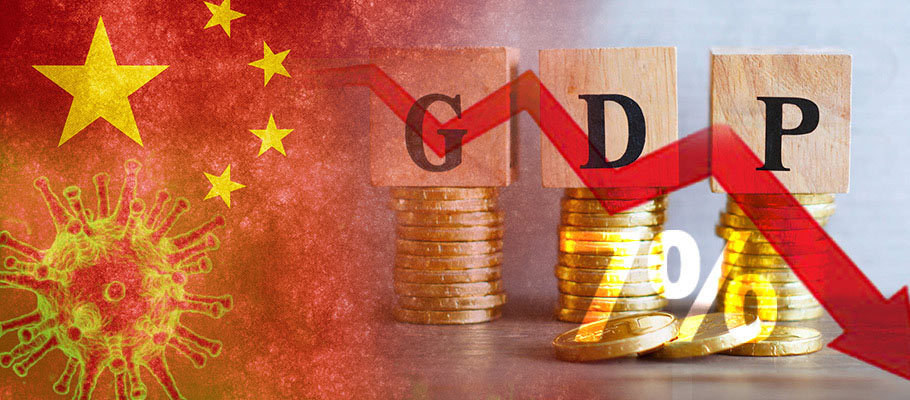
Published: April 21th, 2020
China reports that its GDP has shrunk by almost 7% year-on-year in Q1 of 2020. The grim results are attributed to the coronavirus pandemic which seriously affected the world’s second-largest economy. The report aligns with the results of a poll conducted by Reuters which predicted that the GDP of the populous Asian country would contract by 6.5% in Q1 of 2020.
China reported on Friday, April 18, that its GDP for the first quarter of 2020 has shrunk by 6.8% compared to the same period last year. The coronavirus outbreak substantially affected the populous Asian country according to the data derived from the country’s National Bureau of Statistics.
This steep contraction is the first since 1992 when China first started reporting official quarterly GDP statistics. China’s government figures, however, have come under constant doubt from analysts.
According to an analysts’ poll conducted by Reuters, experts had predicted that China’s GDP would shrink 6.5%. Some 60 analysts were polled and their responses varied. Overall, their projected performance ranged between a drop of almost 30% and a rise of 4%.
The drop is significant considering that China’s economy grew by 6% in Q4 of 2019. Some of the key figures released on Friday that capture the enormity of the drop are the 8.4% decline in industrial production and fixed-asset investment which plummeted by 16.1% during the period of reporting. Retail sales tumbled 19%.
Though sales of consumer goods dropped by 15.8% in March, there was some good news with online sales increasing by 5.9%. Urban unemployment, however, declined to 5.9% in March from a high of 6.2% in February.
Mao Shengyong, the spokesperson for the China National Bureau of Statistics said that the Asian country puts much emphasis on employment and has been stable overall. However, the canceled orders witnessed recently has piled considerable pressure on jobs.
The government official added that China is facing increasing pressure amid the ever-rising uncertainties and unpredictability that has come with the coronavirus outbreak. Additionally, the country is experiencing new challenges and difficulties in resuming work and boosting industrial production.
About half of China’s industrial production was delayed by about a week during the Lunar New Year Holiday in a bid to curb the spread of coronavirus. And, while almost all major industrial enterprises have reopened, smaller businesses have recorded just about 80% return-to-work rate. Besides, business activity is not wholly normal, and there is a noted decline in demand for China’s exports.
The service industry is also only partly open. Mao, however, said that he expects to see China making a comeback. While pointing out that the March data was better than for the previous two months, the spokesperson said that it is highly likely that the country will record better results in April.
Mao’s sentiments are echoed by Bo Zhuang, the chief economist in charge of China at TS Lombard. Bo, however, appealed for caution saying that the March data may not be an accurate benchmark since factories reopened in the same month.
Bo said that while these figures are little but meaningful gains, it is important to note that before March, the global economy expected China to record a V-shaped recovery. He explains that this expectation was so because the world made the onset of the viral outbreak about the supply disruption in China. He added that now the country is seeing an internal demand shock of worrying proportions.
The shocks indicate that even though the virus is partly suppressed and the lockdowns will all be lifted soon; people are still cautious to consume. Bo says that a good indication of this worrying trend is the open malls that get only a few customers if any or none at all.
The analysts said that though the Chinese economy can go either way at the moment, the good news is that if the encouraging March figures are false dawn then everything will become apparent quickly. He, however, was quick to note that the coronavirus outbreak and spread to the rest of the world in March slowed the uptake of Chinese goods. This is the reason why he cannot disregard the possibility that China’s exports and industrial production for April and May falling to another low.
Despite the gloom that has engulfed the world, Chinese officials are still upbeat. According to Mao, the country may attain a 5% growth rate in 2020 and 2021. The official, however, fell short of disclosing the detail of the economic growth targets that Beijing usually sets in March. This year, the meeting to set the annual target has been postponed because of coronavirus.
A separate Reuters poll on the growth of the Chinese economy does is not in line with Mao’s prophesy. The London-based news organization expects the Chinese GDP to grow by a paltry 2.5% down from 6.1% recorded in 2019.
COVID-19 emerged in Wuhan city of Hubei Province in December 2019. And though China has managed to curb the domestic spread, the viral outbreak has degenerated into a global pandemic that has since killed more than 165,000 deaths.
Fears about the effects of the pandemic to major world economies have sent panic waves in the global financial markets. Most analysts are concerned that the situation may lead to a recession.
China announced its economic performance for the past three months that indicates that the GDP of the populous Asian country has sunk by almost 7%. The country suffered the harsh effects of the coronavirus outbreak which started in Wuhan in late December. Available data indicate that a reversal started in March and may continue henceforth. However, the global demand for Chinese products has plummeted with the virus spreading to the rest of the world. The growth experienced in March, as such, may not be sustainable if the lockdown imposed in various major cities is not lifted.